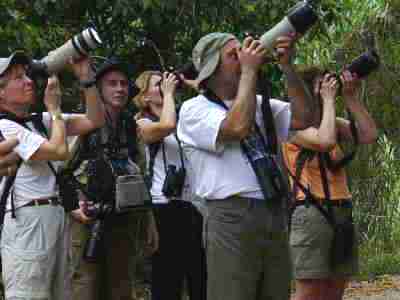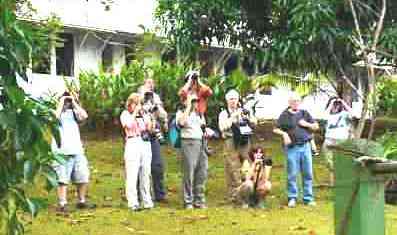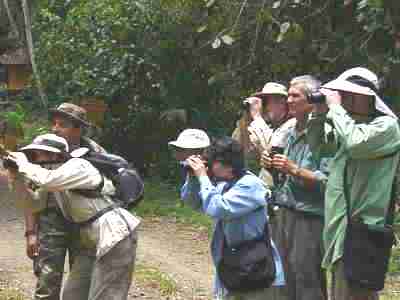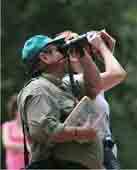Continue the experience at the Atlantic side ,
area north-east of the canal in the Province of Colon. After visiting Achiote Road, go to Parque Nacional San Lorenzo (9,653 hectares/23,853
acres). a vast territory that will demand a complete day and look for
the species that where elusive the day before. The road end at the mouth
of the Chagres River
“the river that has seen more gold than all
the other rivers of the world combined”.
LOCATION
On the Caribbean side of Panama, in the Province of Colon, at
approximately 11 km from the Gatun Dam (Panama Canal), and at the west
side of the San Lorenzo National Park is also call San Lorenzo Protected
Area.
At 2.5 hours from Panama City, you have to cross the Panama Canal
Gatun Locks, with an average waiting time of 30 minutes ( at the lock).
TOUR DIFFICULTY
■
Easy... to Moderate...
to Hard
FITNESS
Easy to moderate walking is required.
■
Easy... to ■ Moderate...
to Hard
WHAT TO EXPECT
With an early morning start expect to see by
noon 60 to 80 species. And by the end of the day a final count of 90+ is
common.
AREA DESCRIPTION
quote this tour
Birding is done primarily along the San Lorenzo road either on foot
along the road or by slowly driving on the way during the first hours.
Also there are many trails and bridges along the way that can be very
productive. There is traffic along the road. Awareness is advised all
the time.
On the way to San Lorenzo you will pass Fort Sherman (FS). A US
military base since the construction of the canal and later on during
WWII used as a Jungle Warfare Military Center until 1999. Most of the
moist forest is ´secondary growth´ and also mangrove swamps along part
of the road to FS. Trails like Pavon Hill, Gatun Drop Zone, Skunk
Hollow, Black Tank are worth a try.

WEATHER
The climate in Central Panama /Canal Zone is usually warm, with
mornings in the 70s and afternoons in the 80s. Conditions at midday can
be humid and very warm, with temperatures reaching into the lower 90s.
Rainstorms may occur at any time of year, but are more likely during the
rainy season, which runs from the summer months into early December.
Generally, the weather in Central Panama is mild and pleasant, with our
activities corresponding to the cooler parts of the day and heightened
bird activity.
ACCOMODATIONS
Easily done as a day trip from Achiote Road or
from Colon City. Achiote village offers
comfortable rustic down to basics clean quarters gender divided -
barrack type with bunk beds - with private showers and bathrooms.
Food service (“restaurante”) is close to installations and is attended
by the ecotourism group Los Rapaces. For reservations
click here,
will be glad to help you at no extra cost.
EATING FACILITIES
There is no restaurant in the area.
CLOTHING
Light clothing is recommended: cotton shirts or t-shirts - earth
colors preferable- long and short pants, poncho, hiking shoes, hat,
insect repellent and sun block. Dress for tropical hot humid weather and
be ready for rain.
GEAR
Binoculars, scope (optional), field guide, notebook and camera
(optional ).
GUIDE BOOK RECOMMENDED
These two books are an example of hard work put into, and for the
benefit, of conserving Panama’s birds:
“The Birds of Panama, a field guide by George R Angehr and Robert Dean Can be described as the “bible” forPanama and some Costa Rica birds. The latest edition (1989).This
excellent field guide is highly recommended as your primary reference
book on the birds.
“An Illustrated Field Guide to the Birds of Panama” by Ernesto
Ponce and Giselle Muschett, 2006, 1st Edition. It can be described as “a
descriptive fieldwork tool” for fast information .
BIRDS TO LOOK FOR
This is a list of birds - by memory - seen along the Achiote Road
and surrounding areas on different tours, and some additions from
friends, guess and people who have collaborated sharing with us their
sightings. The list is continuously on the move. Feel free to send your
findings and comments to
info@birdingbyboattour.com
Check here for the
complete list of Central Panama
Birds.
Great
Tinamu LittleTinamu Black-tailed Trogon Straight-billed Woodcreeper Agami Heron
Hook-billed Kite
Black-crowned Antpitta Black-crowned Night-Heron White-throated Crake
Magnificent Frigatebird Wattled Spot-crowned Barbet
Bare-crowned Antbird
Moustached Antwren
Stripe-breasted Wren
White Hawk
Plumbeous Hawk
American Kestrel
Aplomado Falcon
Rosy
ThrushTanager Gray Hawk
Double-toothed Kite
Pale-vented Pigeon
Ruddy Gground-Dove
BarnOwl Smoth-billed
Ani Palm
Tanager
Common-tody
Flycatcher Blue Ground- Dove
Yellow-crowned Night-
Heron Striped
Cuckoo
Squirrel Cuckoo
Spectacled Owl
Rufous-breasted Hermit
Slaty-tailed Trogon
Violaceous Trogon
Black-tailed Trogon American Pigmy-Kingfisher
Green Kingfisher
Spot-crowned Barbet
Keel-billed Toucan
Collared Aracari
Chestnut-mandible Toucan Yellow-eared Toucanet Black-chested Jay
Cinnamon Woodpecker
Wedge-billed Woodcreeper
Cocoa Woodcreeper
Barred Antshrike
Great Antshrike
Chestnut-backed Antbird
White-necked Puffbird
Black-breasted Puffbird
Pied Puffbird
Fork-tailed Flycatcher
Boat-billed Flycatcher
Piratic Flycatcher
Greenish Elaenia
Black-headed Tody Flycatcher
Long-tailed Tyrant
Brownish Twistwing
Paltry Tyrannulet
Southern Beardless-Tyrannulet
White-winged Becard
Cinereous Becard
Cinnamon Becard
Masked Tityra
Blue Cotinga
Purple-throated Fruitcrow
Golden-collared Manakin
Bay Wren
Black-bellied Wren
Stripe-breasted Wren
White-headed Wren
Scrub Greenlet
Northern Waterthrush
Blue
Dacnis Orchard Oriole
Buff-rumped Warbler
Thick-billed Euphonia
Flame-rumped Tanager
Gray-headed Tanager
Dusky-faced Tanager
White-lined
Tanager Streaked Saltator
Buff-throated Saltator
Lesser Seed-Finch
Yellow-bellied Seedeater
Slate-colored Seedfinch
Yellow-faced Grassquit
Yellow-tailed Oriole
Yellow-rumped Cacique
Crested Oropendola
Montezuma Oropendola
Red-breasted Blackbird





